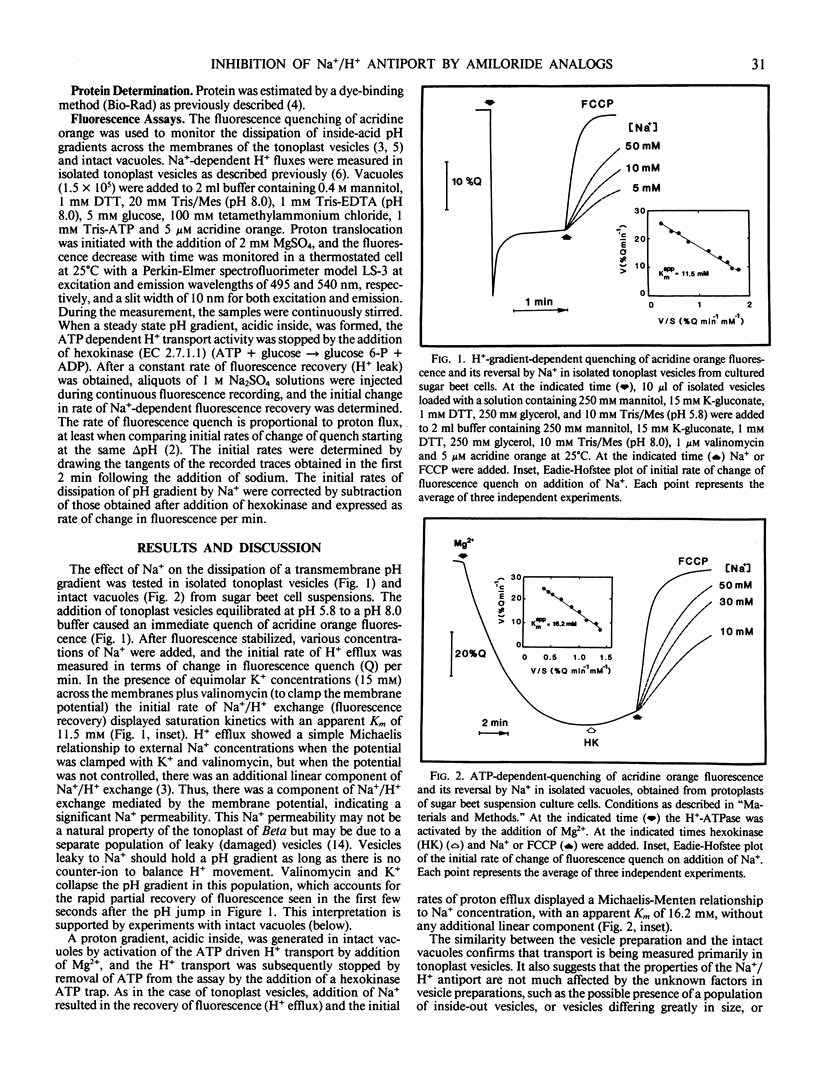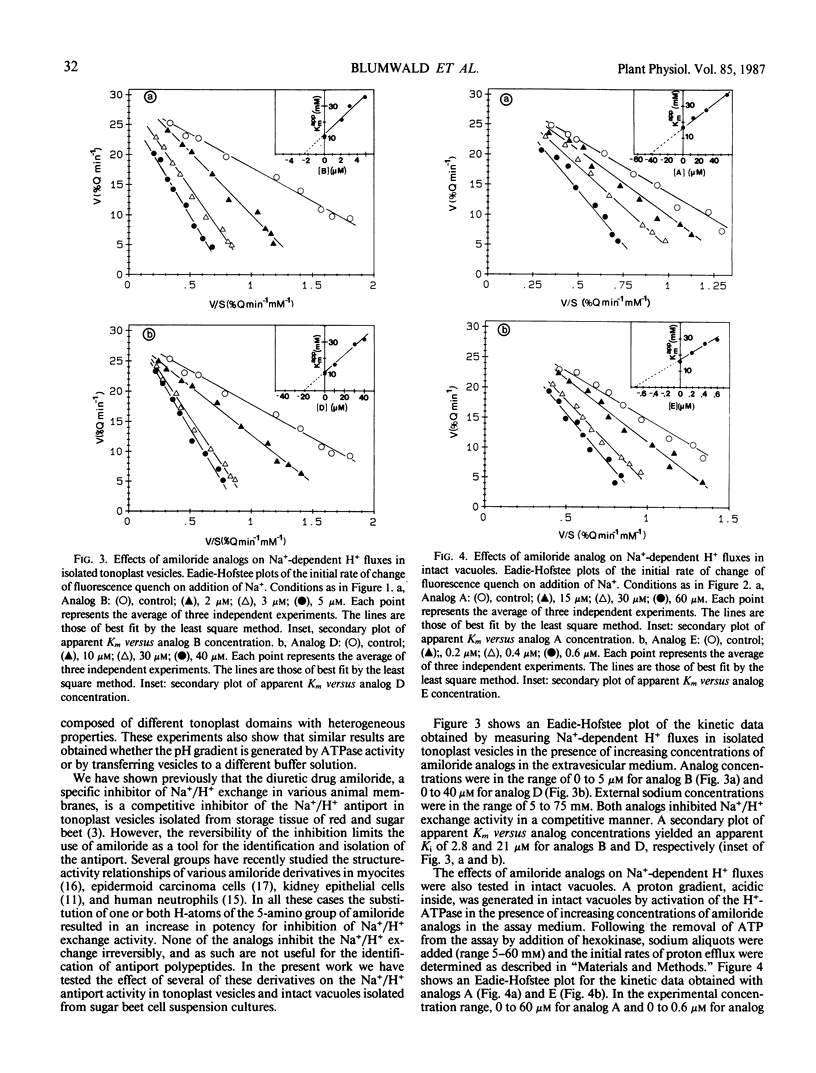Abstract
The effects of amiloride and a series of amiloride analogs have been tested on the Na+/H+ antiport activity in intact vacuoles and tonoplast vesicles isolated from sugar beet cell suspension cultures. There is a competitive interaction between amiloride analogs and sodium. Substitution of one or both H-atoms of the 5-amino group of amiloride (apparent Ki about 150 micromolar) resulted in a 3- to 200-fold increase in inhibitory potency of the antiport activity.
Full text
PDF



Selected References
These references are in PubMed. This may not be the complete list of references from this article.
- Admon A., Jacoby B. Assessment of cytoplasmic contaminations in isolated vacuole preparations. Plant Physiol. 1980 Jan;65(1):85–87. doi: 10.1104/pp.65.1.85. [DOI] [PMC free article] [PubMed] [Google Scholar]
- Blumwald E., Poole R. J. Kinetics of Ca/H Antiport in Isolated Tonoplast Vesicles from Storage Tissue of Beta vulgaris L. Plant Physiol. 1986 Mar;80(3):727–731. doi: 10.1104/pp.80.3.727. [DOI] [PMC free article] [PubMed] [Google Scholar]
- Blumwald E., Poole R. J. Na/H Antiport in Isolated Tonoplast Vesicles from Storage Tissue of Beta vulgaris. Plant Physiol. 1985 May;78(1):163–167. doi: 10.1104/pp.78.1.163. [DOI] [PMC free article] [PubMed] [Google Scholar]
- Blumwald E., Poole R. J. Nitrate storage and retrieval in Beta vulgaris: Effects of nitrate and chloride on proton gradients in tonoplast vesicles. Proc Natl Acad Sci U S A. 1985 Jun;82(11):3683–3687. doi: 10.1073/pnas.82.11.3683. [DOI] [PMC free article] [PubMed] [Google Scholar]
- Blumwald E., Poole R. J. Salt tolerance in suspension cultures of sugar beet : induction of na/h antiport activity at the tonoplast by growth in salt. Plant Physiol. 1987 Apr;83(4):884–887. doi: 10.1104/pp.83.4.884. [DOI] [PMC free article] [PubMed] [Google Scholar]
- Brulfert J., Guerrier D., Queiroz O. Photoperiodism and Enzyme Activity: Balance between Inhibition and Induction of the Crassulacean Acid Metabolism. Plant Physiol. 1973 Jan;51(1):220–222. doi: 10.1104/pp.51.1.220. [DOI] [PMC free article] [PubMed] [Google Scholar]
- Cragoe E. J., Jr, Woltersdorf O. W., Jr, Bicking J. B., Kwong S. F., Jones J. H. Pyrazine diuretics. II. N-amidino-3-amino-5-substituted 6-halopyrazinecarboxamides. J Med Chem. 1967 Jan;10(1):66–75. doi: 10.1021/jm00313a014. [DOI] [PubMed] [Google Scholar]
- Haggerty J. G., Cragoe E. J., Jr, Slayman C. W., Adelberg E. A. Na+/H+ exchanger activity in the pig kidney epithelial cell line, LLC-PK1: inhibition by amiloride and its derivatives. Biochem Biophys Res Commun. 1985 Mar 29;127(3):759–767. doi: 10.1016/s0006-291x(85)80008-5. [DOI] [PubMed] [Google Scholar]
- Lin W., Schmitt M. R., Hitz W. D., Giaquinta R. T. Sugar transport into protoplasts isolated from developing soybean cotyledons : I. Protoplast isolation and general characteristics of sugar transport. Plant Physiol. 1984 Aug;75(4):936–940. doi: 10.1104/pp.75.4.936. [DOI] [PMC free article] [PubMed] [Google Scholar]
- Simchowitz L., Cragoe E. J., Jr Inhibition of chemotactic factor-activated Na+/H+ exchange in human neutrophils by analogues of amiloride: structure-activity relationships in the amiloride series. Mol Pharmacol. 1986 Aug;30(2):112–120. [PubMed] [Google Scholar]
- Vigne P., Frelin C., Cragoe E. J., Jr, Lazdunski M. Structure-activity relationships of amiloride and certain of its analogues in relation to the blockade of the Na+/H+ exchange system. Mol Pharmacol. 1984 Jan;25(1):131–136. [PubMed] [Google Scholar]
- Zhuang Y., Cragoe E. J., Jr, Shaikewitz T., Glaser L., Cassel D. Characterization of potent Na+/H+ exchange inhibitors from the amiloride series in A431 cells. Biochemistry. 1984 Sep 11;23(19):4481–4488. doi: 10.1021/bi00314a038. [DOI] [PubMed] [Google Scholar]


